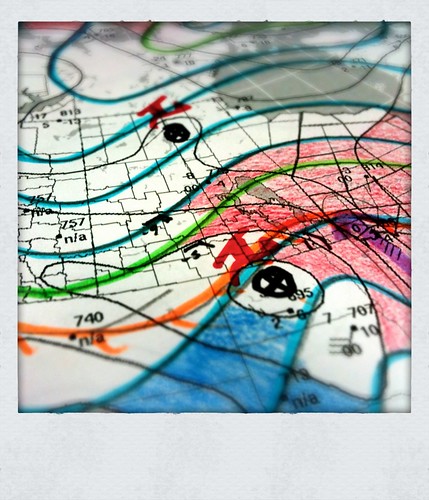The beautiful conditions we’ve had over the past while will take a slight break today, with notably summer-like weather pushing over the Red River Valley. With the Red River and Assiniboine River rapidly rising, how much rain will we see?

A low pressure system currently in Eastern Montana continues to push warm air northwards through the Dakotas towards Southern Manitoba. This warm air brought thunderstorms to Eastern Montana and the Dakotas overnight, and as they have pushed northwards, they have lifted up over the warm front and transitioned to elevated convection that, while weakened, is producing an area of rain that is pushing into our area.

As this precipitation continues to move northwards, away from the warm front, it will weaken as it looses it’s precipitation generating support. The rain that currently resides over the international border will slowly push north, and could give a few light showers to Winnipeg late this morning before it peters out. The main weather that will impact us is currently developing over southeastern Saskatchewan and Southwest Manitoba.

This area of rain visible on the southern edge of the RADAR image will continue to blossom as the low strengthens and overall lift in the area intensifies. This will then begin to track east-northeast later today and spread an area of rain across Southern Manitoba, including the RRV. The models are having some difficulties determining how much precipitation this will produce, which is to be expected, however their tracks for the precipitation are beginning to agree.
GEMLAM
GEM-GLB
GFS
NAM
These models are all from their respectice 06Z runs, except the GEM-GLB which is the 00Z run, showing the precipitation accumulation from 00Z – 06Z tonight. The NAM is a big lighter on the precipitation, but other than that, they all agree (more or less) on location and intensity of the rain. So what will happen?
The precipitation accumulation will vary significantly depending on the amount of embedded convection that manages to develop. Current indications are that after a few showers late this morning, rain will begin to push across the Red River Valley late this afternoon or early this evening. The rain should end over the Southern RRV overnight as the low pulls further north and shifts the precipitation north as well. In Winnipeg, the rain should end sometime early tomororw morning; likely before 8 AM. Total rainfall amounts are difficult to pin down, as it will be directly proportional to the amount of convection that develops, but I would put my money on a general area of 5-10 mm (1/5 – 2/5”). If any significant convection should develop, some areas could potentially see up to 15mm of rain (~ 1/2”).
Once this precipitation clears out, the rest of the weekend will remain a little unsettled. The warm front maintains its position across ND, which will result in the chance of rain over the RRV as convection rides up over the warm front into Southern MB. Next week looks quite nice, however, with mostly sunny skies and temperatures in the low-to-mid teens. How all this precipitation will affect the river levels remains to be seen, however any accumulating precipitation has people concerned with the extremely high river levels that already are impacting the RRV. For more flood information, Rob over at Rob’s Blog has put together a nice collection of flood links.









